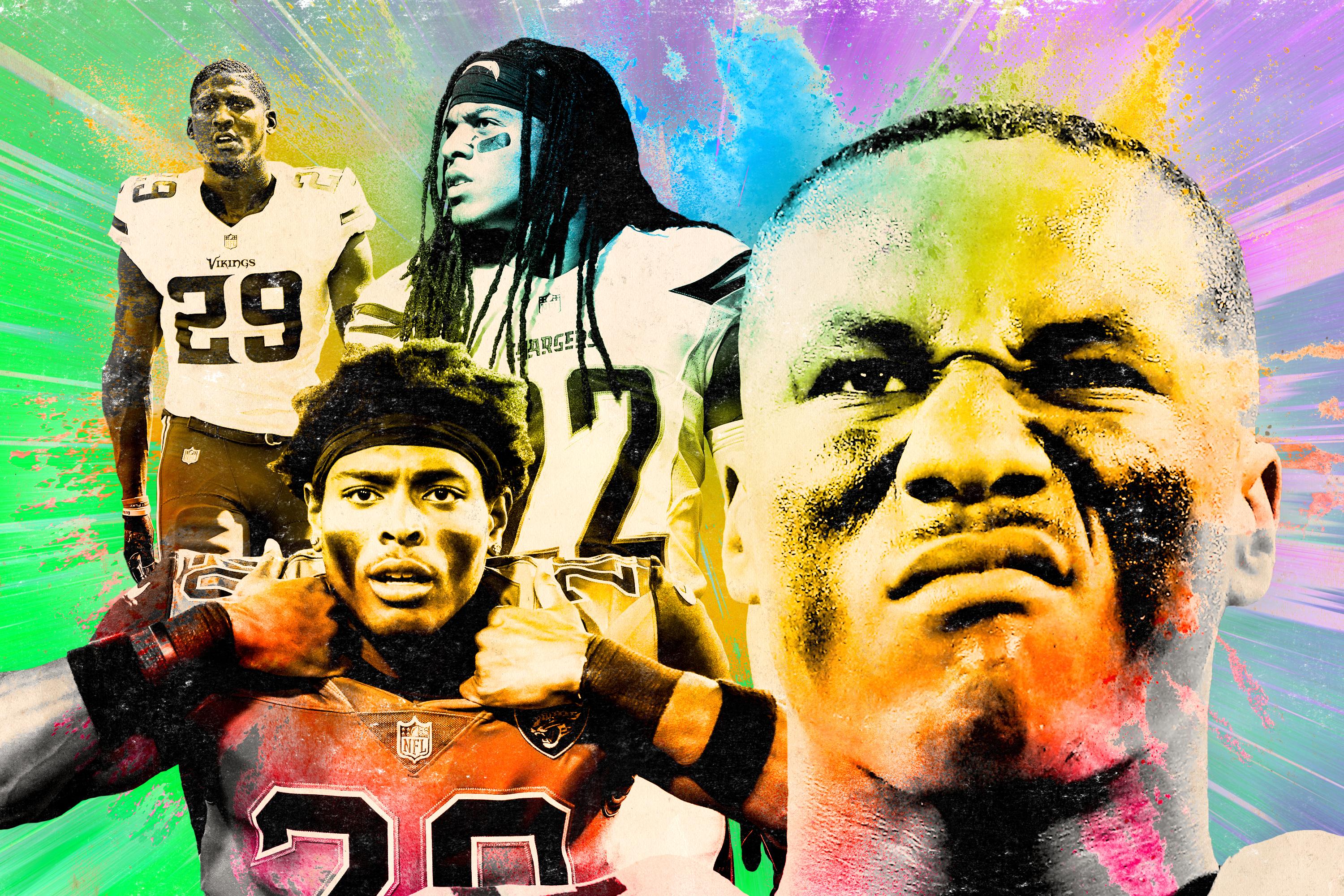Who Will Be the NFL’s Next Legion of Boom?
With Kam Chancellor’s retirement, the days of the Seahawks dominating quarterbacks are officially done. Which team will take up the mantle?
Seahawks safety Kam Chancellor announced last week that he’s walking away from football, marking a solemn end to an outstanding career—and the formal close to the Legion of Boom era in Seattle. But while one of the best secondaries in league history has now been relegated to the past tense, there’s no shortage of defensive units ready to take up the LOB’s mantle. Here is a handful of squads with the potential to become the NFL’s next great secondary.
The Favorites
Jacksonville Jaguars
The numbers the Jags’ secondary posted last season are, well, absurd. Jacksonville’s pass defenders turned opposing quarterbacks into a collective Brock Osweiler–level passer (actually, worse) last year, holding QBs to a 68.5 passer rating, the lowest mark by any group since the Seahawks’ 2013 Super Bowl squad (63.4). The Jags finished the year with a league-high 4.1 percent interception rate and grabbed 21 picks (second most) while surrendering just 17 pass touchdowns (tied for third fewest). They allowed 6.0 yards per pass attempt (tied for first) and 4.9 adjusted yards per pass attempt—which gives a quarterback a 20-yard bonus for touchdowns and a 45-yard penalty for interceptions—again tops for any defense since the 2013 Seahawks. They gave up 169.9 passing yards per game (first, and best since the 2009 Jets), and a completion rate of just 56.8 percent (again, first). By just about every meaningful measure, they were completely dominant.
That unit is led by fiery corner Jalen Ramsey, whose prodigious talent for trash-talking is downright Richard Shermanesque. Only two years into his career, Ramsey has already established himself as one of the league’s premier shutdown corners, and in 2017 he gave up a catch on just 51 percent of his 92 targets in coverage, allowing a 63.9 quarterback rating against (10th), per Pro Football Focus. He grabbed four interceptions and defended 17 passes (tied for 11th) while giving up just three scores. Somehow, the guy opposite him posted even more impressive numbers: A free-agent newcomer, A.J. Bouye allowed a league-low 31.6 quarterback rating against, per PFF, finished tied for third in the league with six interceptions, and tied for sixth with 18 pass deflections. Even when an opposing receiver managed to reel in a pass, Bouye was stingy, allowing just 72 yards after the catch on 38 receptions. Bouye and Ramsey easily make up the best cornerback duo in the NFL.
Jacksonville has the middle of the field locked down, too: Tashaun Gipson and Barry Church finished with four interceptions apiece last year, grabbing a combined 15 pass deflections while allowing just three touchdowns in coverage.
We can’t completely separate the exploits of the Jags’ playmaking back end from its elite pass-rushing front, which ranked third in the NFL in pressure rate (registering a sack, hurry, or forced scramble on 35.2 percent of opponent pass plays) and earned the defense its Sacksonville moniker. But the secondary stayed in lockdown mode even when pressure failed to get home, finishing the year first in Football Outsiders’ defensive DVOA on non-pressured pass plays. Jacksonville will have to make due without slot corner Aaron Colvin, who left for Houston in free agency, but newcomer D.J. Hayden is ready to step into that role.
Minnesota Vikings
The Vikings, thanks in part to the rare continuity the starters have enjoyed in Mike Zimmer’s complex system, posted some unbelievable pass-defense numbers of their own last year. Minnesota allowed an opponent passer rating of 73.0 (third), 6.0 yards per attempt (tied for first), 5.3 adjusted yards per attempt (second), 192.4 pass yards per game (second), and just 13 passing touchdowns on the year (first). The Vikings ranked third in defensive DVOA without pressure, and got better as the year went on, finishing tops in weighted DVOA, which factors late-season play more heavily. And, critically, they return all their key contributors.
Safety Harrison Smith remains the anchor in the middle, and notched 12 passes defensed and five picks en route to All-Pro honors last year. Smith was deployed deep as well as up in the box and was equally strong against the pass and the run, playing a crucial role in the team’s historically great performance on third downs, for which they gave up a league-low conversion rate of just 25.2 percent (the best mark for any team since at least the 2002 season). Next to Smith, Andrew Sendejo was no slouch, finishing with 52 tackles, two picks, and seven passes defensed.
On the outside, the team’s cornerbacks group is headlined by Xavier Rhodes, who’s already entrenched as one of the league’s best. Last year, the 27-year-old picked off two passes and knocked down another 10, surrendering a paltry 73.2 passer rating in coverage while earning first-team All-Pro honors. Rhodes is flanked by the ageless Terence Newman (one interception, 76.7 passer rating against in 2017), third-year pro Mackensie Alexander (six passes defensed, one pick, 71.1 passer rating against), and Trae Waynes (two interceptions, 83.0 passer rating against), who, entering his fourth year, could be a breakout candidate. Oh, and Minnesota just added first-round corner Mike Hughes to the group. This Vikings secondary may just be getting started.
Los Angeles Rams
With a flurry of offseason moves, the Rams—who finished third last year in defensive pass DVOA—have assembled what could be, at least in the short term, the secondary with the highest upside in the NFL. At safety, the team returns three key starters: Lamarcus Joyner, who broke out after moving from corner to free safety in Wade Phillips’s scheme last year; John Johnson, the team’s promising second-year pro; and Nickell Robey-Coleman, L.A.’s reliable slot corner.
But on the outside, new additions bring the potential for a major jump forward. Cornerback Marcus Peters, acquired in a trade with the Chiefs, brings to L.A. a unique nose for the football, with 19 interceptions, 55 passes defensed, and five forced fumbles on his résumé after just three pro seasons. Aqib Talib, a five-time Pro Bowler acquired in a separate deal with the Broncos, slides in on the opposite wing.
The Rams will have to turn their new mix of playmakers into a cohesive unit, but at least on paper, their defensive backfield looks ready to reign supreme.
Los Angeles Chargers
The Chargers quietly posted elite defensive numbers last year as well, holding quarterbacks to a passer rating of 78.1 (fourth), 6.5 yards per attempt (tied for third), and 5.6 adjusted yards per attempt (fourth). L.A. gave up just 197.3 pass yards per game (third) and 17 passing scores (tied for third), and picked off 18 passes (tied for sixth).
That group was led by Casey Hayward, who, for the second straight year, proved he’s one of the best in the game, allowing only 42.7 percent of the passes that came his way to be completed, per PFF. On the year, Hayward surrendered a 58.6 passer rating on 566 snaps in coverage, picked off four passes, and knocked down 22 more (tied for second). Opposite him, Trevor Williams emerged as a high-quality starter in relief of an injured Jason Verrett, allowing a 70.5 passer rating against in coverage, and rookie nickel corner Desmond King stood out, too, allowing just 31.9 yards per game in coverage while surrendering zero touchdowns on 380 snaps from the slot. Oh, and this corners group gets a Pro Bowl–caliber player in Verrett back into the mix.
At safety, veterans Jahleel Addae and Adrian Phillips return, bolstered by the addition of versatile rookie first-rounder Derwin James. The Chargers secondary benefits from playing behind one of the NFL’s best young pass-rush duos in Joey Bosa and Melvin Ingram, but this team still finished eighth in pass defense DVOA when no pressure got to the QB. It’s a lockdown coverage unit, and with a little luck in the health department, it will only get better in 2018.
Baltimore Ravens
The Ravens’ back end might not get as much hype as some of the teams listed above, but it’s as solid a unit as any in the league. Baltimore ranked second in pass defense DVOA last year, second in opponent quarterback rating (72.4), tied for third in yards per pass attempt (6.5), and third in adjusted yards per attempt (5.4), and finished with more interceptions (22—tops leaguewide) than passing touchdowns allowed (18).
Leadership came from the safety spot, where five-time Pro Bowler Eric Weddle (six picks, two forced fumbles) and free-agent addition Tony Jefferson teamed up to patrol the middle of the field. On the outside, the team had three corners in the top 15 in quarterback rating against: Before suffering a torn Achilles in early December, Jimmy Smith was playing at an All-Pro level, with three picks and a 49.2 passer rating against (fourth); rookie Marlon Humphrey, who saw more time as the year went on, impressed with two picks and a 53.5 passer rating against (fifth); and longtime veteran Brandon Carr posted four interceptions and a 69.1 opposing quarterback passer rating in coverage (15th). Add in Maurice Canady, plus the return of slot corner Tavon Young, who played well as a rookie but missed all of last year due to an ACL injury, and the selection of rookie Anthony Averett, and this unit should once again be among the best of the best in 2018.
The Contenders
Chicago Bears
It took a little free-agency finagling, but the Bears managed to hold on to every key member of their underrated secondary from last season. Cornerback Kyle Fuller was the biggest get, signed to a four-year, $56 million extension, and the fifth-year pro will have the chance to show that his breakout performance in 2017 (two picks and 22 passes defensed) was no fluke. Opposite Fuller, reliable veteran Prince Amukamara comes back on a three-year, $27 million deal, and is flanked by promising slot corner Bryce Callahan, who signed a restricted free-agent tender to stay with the team.
Adrian Amos and Eddie Jackson look primed to emerge as one of the best young safety duos in the league. The Bears have the foundation for a top-tier unit—a group that finished 10th in DVOA without pressure last season—and they have a chance to prove they belong among the elite in 2018.
New Orleans Saints
It didn’t take Marshon Lattimore long to turn into one of the league’s stingiest coverage defenders, grabbing five picks while surrendering a 45.3 passer rating, third best, in his rookie season. And that botched tackle in the NFC divisional playoffs game against the Vikings aside, rookie safety Marcus Williams had an outstanding year for New Orleans. Along with Ken Crawley, P.J. Williams, and Vonn Bell, the Saints have an exciting young defensive core to build around, and their unit ranked fifth in both overall pass defense DVOA and DVOA without pressure.
Add in veteran slot corner Patrick Robinson, a key member of the Eagles’ Super Bowl team last year, and safety Kurt Coleman, and this unit looks ready to make a big jump.
Buffalo Bills
The Bills made two of the best free-agent moves in the league last year in adding safeties Micah Hyde and Jordan Poyer, a duo that changed the complexion of the team’s secondary and combined for 10 picks and 26 passes defensed. The team’s selection of cornerback TreDavious White in the 2017 first round looks visionary as well: The rookie picked off four passes and knocked down 18 more after being trusted to start so early in his career. That secondary trio’s coverage in the back end helped the team finish fourth in DVOA without pressure—a big reason Buffalo earned its first playoff appearance in 18 years.
This Bills secondary has plenty of talent, but still has a few important questions to answer: Can Hyde and Poyer re-create their middle-of-the-field magic again in 2018? Can veteran free-agent signee Vontae Davis replace the departed E.J. Gaines and turn back into the elite playmaker he was earlier in his career? And can Phillip Gaines revive his career as a dependable slot option for this defense? We’ll soon find out.
The Upside Is There
Atlanta Falcons
Talent’s certainly not a problem for the Falcons secondary, with a core group that includes cornerbacks Desmond Trufant, Robert Alford, and Brian Poole, and safeties Keanu Neal and Ricardo Allen. But after reeling in just eight picks last year (tied for 29th leaguewide) and allowing a 91.9 opponent passer rating (tied for 20th), the team’s overall pass defense numbers underwhelmed. Narrowing the focus, though, the Falcons really shined inside their own 20-yard line, finishing fifth in both touchdowns allowed and points per opponent red zone trip. Atlanta’s ability to tighten up coverage and lock down receivers when it mattered the most, in close to their end zone—serves as an indication that this group, especially with the additions of former Cardinal Justin Bethel, rookie Isaiah Oliver, and Kansas City safety Ron Parker, could make a big jump in 2018.
Cincinnati Bengals
After missing his entire rookie year due to a pectoral injury, second-year pro William Jackson III was quietly one of the most exciting corners in the league last year, allowing an NFL-low 34.9 percent of passes thrown his way to be completed, per PFF, while surrendering a 36.1 passer rating against (second only to Bouye) on 396 coverage snaps. And alongside secondary-mates Darqueze Dennard, Dre Kirkpatrick, George Iloka, and Shawn Williams (plus rookies Jessie Bates, Darius Phillips, and Davontae Harris), Cincy boasts a talent-packed young nucleus in the back end. Except this squad picked off just 11 passes (tied for 20th), and relied way too heavily on pressure last year, finishing fourth in DVOA when pressure came but 30th without it. This group has the youth to make a surprise jump, but needs to prove it can cover and make plays downfield when its pass-rushing front can’t get through.
Denver Broncos
The Broncos might be keeping the “No Fly Zone” nickname, but this is a different group than the one that earned it. Two pillars of that legendary 2015 squad, safety T.J. Ward and cornerback Talib, are gone, meaning the remaining core—cornerbacks Chris Harris Jr. and Bradley Roby, and safety Darian Stewart—will have to shoulder a heavier load. But add in Justin Simmons, Tramaine Brock, and a high-upside talent like Su’a Cravens, and Denver’s new-look defense could live up to its venerated name.

